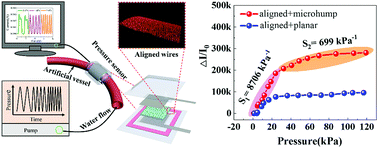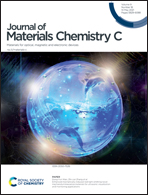Tunable piezoresistivity of low percolation threshold micro-nickel wires/PDMS conductive composite regulated by magnetic field†
Abstract
High-performance flexible pressure sensors with tunable piezoresistivity are proposed with percolative composites as a single sensing layer using micro-nickel (μNi) wires as the conductive filler and polydimethylsiloxane (PDMS) as the matrix. The μNi wires were dispersed in PDMS and cured in a magnetic field of 17 mT to align the μNi wires along the direction of the magnetic field. An ultra-low percolation threshold (0.31 vol%) has been achieved, which is more than an order of magnitude lower than the 4.79 vol% of the control sample without a magnetic field. The pressure sensor with microhump structures based on Ni@PDMS composites with a volume fraction of 0.6 vol% molded by sandpaper exhibited ultrahigh averaged sensitivity (8706 kPa−1), a wide sensing range of 1 kPa to 120 kPa and a fast response time of ∼22 ms. The sensor was used to monitor different frequencies and flow rates of water flowing in a pump-driven system that mimics the pulsatile behavior of the coronary artery, and judge whether the graft vessel is blocked or not, showing high potential for application in clinical diagnosis.



 Please wait while we load your content...
Please wait while we load your content...